by aramatzne@gmail.com | 27 Sep 2017 | Musing
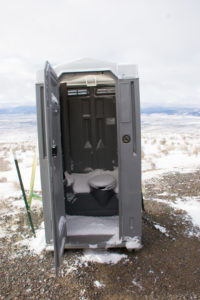
An outhouse door blown open by the winter winds leaves a girl out in the cold.
The absolute opposite of being on the hot seat.
Worksite management specifically rented outhouses as a “courtesy” to the girls on site.
I took this photo as an example of a good idea poorly implemented. Those who don’t have to sit down, don’t always understand the importance of latching the door.
Like this:
Like Loading...
by aramatzne@gmail.com | 25 Sep 2017 | Musing
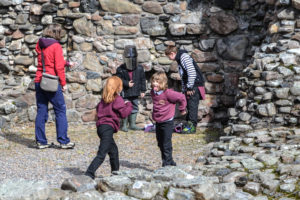
While children play, the Knight in Wellies stands watch.
There’s one in every class. You know the kid, the one who is always just on the fringe. Not quite fully accepted- and sometimes not fully interested in being accepted.
They keep to themselves. They have their own drummer. While other kids stick out their tongues and jostle each other, they stand guard in their knight’s helmet and Wellies.
I took this photo in Scotland’s Balvenie Castle adjacent to the Balvenie distillery. This is something one may imagine they have seen after a dram or two of good single malt whisky, but I was stone cold sober. And I did not attempt to fit in by donning a lampshade.
Like this:
Like Loading...
by aramatzne@gmail.com | 23 Sep 2017 | Musing

Morning clarity in the rearview mirror.
The rain moved ahead of me. It passed through town and across the plateau before following the river west. The same route I was taking.
Summer rain in the sagebrush desert is something worth celebrating. It washes the dust out of the air. As the air warms again almost immediately, it smells of earth and water and life.
It is unmistakable. It breaks through the dust in my brain to remind me that time and space are ever fluid. That whatever may settle here now will wash away with the next downpour.
I took this photo as I entered the storm, the Columbia River bluffs and calm water behind me, foretelling the clarity that comes with the passing rain.
Like this:
Like Loading...
by aramatzne@gmail.com | 22 Sep 2017 | Musing
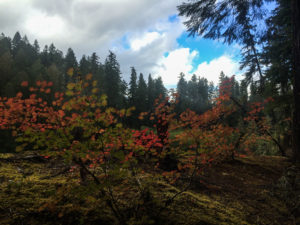
Cascade color
Today is the autumn equinox. Halfway between the light and the dark, three-quarters of this year’s spin around the sun.
The sun seems as reluctant to rise in the morning as I am. And sets again too soon. In exchange for less light, there is more color and the forest is once again vibrant with the autumn rain.
I took this photo when the trees were half red, the sky half blue. Together they made the day wholly perfect.
Like this:
Like Loading...
by aramatzne@gmail.com | 21 Sep 2017 | Musing
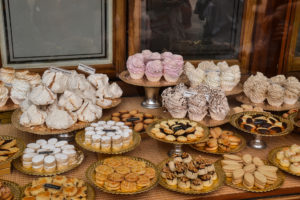
Dive through the window
I took this photo but I didn’t eat a single thing.
They must have been closed.
I can think of no other explanation.
Like this:
Like Loading...
by aramatzne@gmail.com | 18 Sep 2017 | Musing
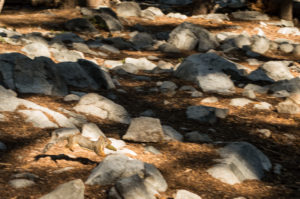
Fall caching; squirrel on the move.
This is a cautionary tale.
A chipmunk spent its morning trying to pilfer any bit of food it could find from my campsite. The food was packed, hung, and covered. There were no bits lying around, no dirty dishes, no tossed veggie scraps. The chipmunk tried every angle, checked every stuff sack and container to no avail.
Meanwhile, a squirrel spent its morning dashing through the campsite. It collected cones in trees near the lake, ran through camp with a cone in its mouth, and then into the alders along the edge of the lake’s outflow meadow. A few minutes later, having stashed the cone in some secret place, it would run back to camp, stop to look at me over my pack or across the fire ring, and then continue on its path. It didn’t disturb any of my things or even sniff at the stuff sacks. Every five minutes it made another roundtrip through camp.
After a couple of hours, the chipmunk was still angling for something easy and free, although it seemed to have less enthusiasm at this point. It stopped to scold me occasionally as if to say, “How dare you! Where is my breakfast?” It would disappear for ten or twenty minutes and then reappear to once again check every item. Just in case.
The squirrel also scolded me but it was because I inadvertently stepped into its path when it was crossing camp. Halfway through the morning, the squirrel stopped for a snack – a cone he found near one of his supply trees – and then went back to work.
Returning to my briefly unguarded teacup, I found two tiny droplets on the rock next to it. Inside the rim of the cup, there were two little, wet paw prints. The cup was otherwise undisturbed, not knocked over, no floating debris, just two perfect paw prints.
I took this photo by predicting the squirrel’s movement along the same path through camp. It was reliable, as is his winter food supply. The chipmunk only got wet feet for his morning’s work.
Like this:
Like Loading...






